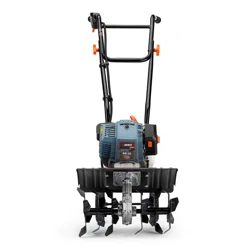Loading ...
Loading ...
Loading ...

6 www.senixtools.com
fumes may be trapped and not easily
taken away. (Examples include: in
a large hole or areas where hills
surround your working area.)
• Never run engine in an enclosed or
partially enclosed area. (Examples
include: buildings that are enclosed
on one or more sides, under tents, car
ports or basements.)
• Always run the engine with the
exhaust and muffler pointed in the
direction away from the operator.
• Never point the exhaust muffler
towards anyone. People should
always be many feet away from
the operation of the engine and its
attachments.
• Do not change the engine governor
settings or over-speed the engine.
Gasoline Fires and Handling Fuel Safely
• Use extra care in handling gasoline
and other fuels. They are flammable
and vapors are explosive.
• When storing extra fuel be sure that
it is in an appropriate container and
away from any fire hazards.
• Prevent fire and explosion caused
by static electric discharge. Use only
nonmetal, portable fuel containers
approved by the Underwriter’s
Laboratory (U.L.) or the American
Society for Testing & Materials
(ASTM).
• Always fill fuel tank outside in a well
ventilated area. Never fill your fuel
tank with fuel indoors. (Examples
include: basement, garage, barn,
shed, house, porch, etc.) Never fill
tank near appliances with pilot lights,
heaters, or other ignition sources.
If the fuel has to be drained, this
should be done outdoors. The drained
fuel should be stored in a container
specifically designed for fuel storage
or it should be disposed of carefully.
• Never remove the fuel cap or add fuel
with the engine running. Stop engine
and allow to cool before filling.
• Never drain fuel from engine in an
enclosed area.
• Always wipe up excess (spilled) fuel
from engine before starting.
• Clean up spilled fuel immediately. If
fuel is spilled, do not start the engine
but move product and fuel container
from area. Clean up spilled fuel and
allow to evaporate and dry after
wiping and before starting.
• Allow fuel fumes/vapors to escape
from the area before starting engine.
• Test the fuel cap for proper installation
before starting and using engine.
• Always run the engine with fuel cap
properly installed on the engine.
• Never smoke while refilling engine fuel
tank.
• Do not store engine with fuel in fuel
tank indoors. Fuel and fuel vapors are
highly explosive.
• Never siphon fuel by mouth to drain
fuel tank.
• Always have an adult fill the fuel tank
and never allow children to fill the fuel
tank.
• Never allow an adult or anyone under
the influence of drugs or alcohol to fill
the fuel tank.
• When storing gasoline or equipment
with fuel in the tank, store away from
furnaces, stoves, water heaters or
other appliances that have a pilot light
or other ignition source because they
can ignite gasoline vapors.
WARNING:
ENGINES GIVE OFF CARBON
MONOXIDE, AN ODORLESS,
COLORLESS, POISONOUS GAS.
CARBON MONOXIDE MAY BE
PRESENT EVEN IF YOU DO NOT
SMELL OR SEE ANY ENGINE EXHAUST.
BREATHING CARBON MONOXIDE
CAN CAUSE NAUSEA, FAINTING OR
DEATH, IN ADDITION TO DROWSINESS,
DIZZINESS AND CONFUSION.IF
Loading ...
Loading ...
Loading ...
